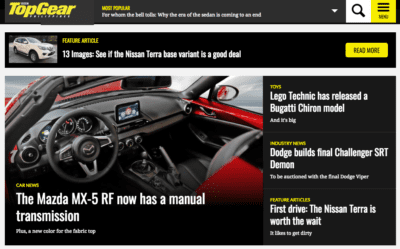|
Getting your Trinity Audio player ready...
|
In April of this year, the Philippines’ leading lifestyle publisher, Summit Media, closed all its 23-year old print assets and completed its full transformation to digital. President Lisa Gokongwei-Cheng shares how they stepped away from an outdated business model and turned print into a digital-first success story.
With between 21 to 25 million unique monthly users visiting its 15 lifestyle brand websites and 33 million more fans following its brands on social media platforms, Summit Media reaches more than 25 per cent of the Philippines’ Internet population.
Content of every single Summit title – including Cosmo.ph, Townandcountry.ph and Topgear.com.ph – is now created digitally first and consumed digital-only.
But this wasn’t always the case. For 23 years, Summit Media published the most successful and well-loved magazines in the country’s history, enjoying boom years in the 90s when magazine prosperity shadowed the economic boom that followed the demise of the Ferdinand Marcos dictatorship. While Summit Media’s print titles had a solid legacy despite being in its infancy in a society with new media freedoms, local market forces emulated exactly what was happening in the rest of world: print advertising was on the decline and a young magazine market was easy prey for digital disruption. By 2014 the need for change was clear and Summit Media started its transformation from print to digital.
Such a radical transformation required organisational and skills agility, a ‘just do it’ attitude, the willingness to harvest print assets and embrace data, says Summit Media president Lisa Gokongwei-Cheng. In the process they also learnt many lessons.
Investing as you grow
“We could see print softening four years before our full transformation. That year, we started our digital transformation in earnest. We set up a new organisation to run parallel to our print organisation because we knew that change could only happen in those terms. Remaining under the print umbrella would stifle any digital activity. That would be my first learning.”
In practical terms this meant that the digital side of the business had its own general manager, its own set of editors, and even it own set of publishers. To achieve this Summit hired new talent in technology, data and video. The only shared team between digital and print was advertising sales because they owned the relationship with clients, explains Gokongwei-Cheng.
She also warns that transformational success cannot happen if you are inclined to continue to protect your outdated business model. “Just do it… Do not protect you current business model. Put in a small team first and then invest money as you grow. You then learn things along the way. In hindsight, we were quite agile in our way of working even if we were not familiar with exact needs for agility at that time.”
In any digital transformation, the first step is to identify what assets can be carried from the traditional business to the new one, says Gokongwei-Cheng. “Our print brands gave us audience understanding and advertiser relationships. For instance, our brand Cosmopolitan is the leading young women’s site, reaching on average 3 million readers monthly on our website and millions more on special media. The brand which was the biggest women’s title in print helped build (digital) credibility immediately for both readers and advertisers.”

Embracing data
Last, but far from least, says Gokongwei-Cheng, they knew they had to encourage their teams to embrace and mine data immediately. To make this happen they invested heavily in building – or renting – tools that would make easy to access and understand data, from Google, Twitter, Facebook and even their competition to be able to to create story line ups.
“We also use the same tools to help us pitch ideas to advertisers for native or content marketing products. So say a shampoo advertiser comes to us and asks for insight. We can tell them, based on our data that for 18 to 24 year-old women, hair trends are huge. In the process we help our advertisers to create stories around popular themes.”
Today behavioral data is used to sell direct display to advertisers. “So if a car advertiser comes to us and says we want people who have read road trip stories across our network, we can help them to do the targeting. Our next step is to build richer profiles and use them for better and more predictive targeting and insighting and integrate them with client data as well,” says Gokongwei-Cheng.
All of this ensured that Summit Media built their digital organisation around embracing data. “We now use data in everything we do. Even the editors who used to hate it, now love it because it allows them to understand their readers more, and there’s feedback 24/7.”
Keeping advertisers on board
Ensuring that advertisers were ready for the transformation and staying on board were of vital importance. Several years before the announcement, Summit Media started educational roadshows for advertisers and for three years sponsored an annual digital media event attended by close to 1,000 advertisers. They invited speakers from all over the world to share the latest trends in digital media.
“This helped our advertisers understand digital media and also helped build our brand in the media space. It also helped that many of our advertisers were already in digital when we made that shift but there were also a little over a hundred clients who were still doing print-only. These were the people we had to talk to. But many were actually congratulating us and letting us know they would continue their support. I think it was perfect timing – the soil was ready for the seed to be planted.”
It did, however, take some time for the advertising teams to embrace digital. “It was so much easier to sell a magazine insert,” laughs Gokongwei-Cheng. “So in the beginning, we introduced digital specialists who only sold digital. They would accompany the print people to sales calls and took the responsibility of explaining the nitty gritty of digital to advertisers. Then in the second year, as the print people started to pick it up, we abolished the specialists, and everyone had to sell all platforms.”

Summit Media’s overall approach to making this transition proved to be a wise investment in organisational change, talent and tools, attests Gokongwei-Cheng. “By the time we were ready to close print, many of the digital platforms were already more profitable than their print counterparts. We were also fortunate enough to lead our competitors who had not made that shift. The owners and management team agreed that we should focus our resources on the growth business to make sure we cemented that lead instead of spending them on keeping a declining business alive.”
Re-published by kind permission of FIPP, the network for global media


